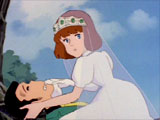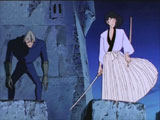

Quick Links:
Lupin III: The Castle of Cagliostro
Given its level of quality, it's hard to believe that Castle of Cagliostro was crafted by a rookie director. But then again, Hayao Miyazaki has yet to dissapoint. The film is classic Lupin III wackiness, but it also has something else; an undeniable elegance which radiates outward from every element. The chief difference between the film and other Lupin III works is style. Castle of Cagliostro plays out with grace, making this installment of Lupin III well-rounded, and consequently more enjoyable and sophisticated.
Castle of Cagliostro carries along all the classic Lupin III elements. We have Lupin and Jigen, partners in thievery (and good at it). Joining in the antics are the well-endowed and witty Fujiko, and the mysterious samurai Goemon. On the opposing side, we have the ever-determined Zenigata, an investigator for Interpol who chases Lupin to the ends of the Earth (and still doesn't catch him). Most of the Lupin stories revolve around searching for some grand treasure and chasing after a pretty girl, and this one is no different.
After robbing a casino and discovering that their loot consists wholly of counterfeit "Goat bills," Lupin and Jigen travel to the independent nation of Cagliostro, the believed source of the Goat bills. Upon arrival, they get wrapped up in a high speed car chase, trying to protect a cute girl in a wedding dress from a band of goons in black suits. She slips Lupin her family ring before being captured. Later they find that she is Clarisse, daughter of the late Duke and ruler of the country. She is to be wed to the Count of Cagliostro, obviously against her will. Well, of course Lupin has to save the girl, in addition to getting even with those who robbed him of his money that he...robbed from someone else.
The plot is rather ordinary for a Lupin III work, but the dialogue helps give the film a unique feel. At times, it feels much more like the typical Miyazaki movie than a Lupin III movie. Clarisse is typical Miyazaki fare, with a childish innocence and adorable nature. She is almost solely responsible for how charming the story is, as she is the kind of girl any man would try to protect.
The character designs of this Lupin III work are for the most part no different from the Lupin TV series. Lupin looks somewhat like a monkey in a suit (and acts like one too). Jigen is perhaps one of the more amusing characters in terms of appearance, always having an already-smoked cigarette in his mouth, and wearing the hat that never comes off (even when underwater). The square-chinned Zenigata and classic samurai Goemon are always funny to look at too, as is Fujiko in her goofy outfits. The design for Clarisse is quite eye-catching, with the pretty red hair and blue eyes. Those features really stand out, since she's dressed in light clothing. The animation in Castle of Cagliostro is dated, for sure, but still well-done. If nothing else, the old animation tricks serve to make Lupin's antics more funny.
Castle of Cagliostro's music has somewhat of an antiquated feel, but fits the romantic aura of the film very well. The beginning and ending themes are the same song, Honou no Takaramono (Fire Treasure). The song is a graceful and sweet melody, capturing the mood of the European countryside.
Miyazaki fans that for some reason haven't seen this movie should definitely pick it up, as should Lupin III fans in general. Castle of Cagliostro marked a change in the world of anime, one which led to the ever-influential Ghibli style of animation that continues to enchant audiences around the world. Because of its irresistable allure and wacky, light-hearted humor, the film gets a high recommendation from yours truly.
Distributor: Manga Entertainment Creator: TMS / Hayao Miyazaki Released: 1980
Plot: A- Character Design: B+ Animation Quality: A Music: B+ Overall: A



